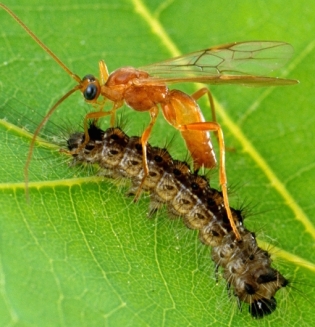In a long con lasting nearly 100 million years, a crafty braconid wasp stole a virus’s DNA to control the immune system of its prey.

Image credit: Scott Bauer, USDA Agricultural Research Service
Braconid wasps are unique parasites that lay their eggs inside unsuspecting butterfly or moth larvae, in which newly hatched wasps feed on relatively nonessential organs. Normally the immune system of the host defends against these attacks, but the wasps have a secret weapon in their arsenal: a domesticated virus from the Cretaceous period used to ensure the prey stays incapacitated but alive…until the young wasps are old enough to search out alternative food sources, that is.
The viruses coopted by braconid wasps are a type of polydnavirus (PDV), an infectious agent barely recognizable as a virus at all. Typical “everyday” viruses—like influenza or the common cold—contain all of the genetic information needed to replicate, but the genes involved in PDV reproduction are stored within the wasp’s DNA, which is an odd habit for a virus. As a result, the wasps more or less control the manufacture of the viruses and produce them at will.
Nearly 100 million years ago when the DNA coding for PDV replication was integrated into the wasp’s genome, virulence genes encoding wasp venom were transferred into the virus. Like Cold War-era microfilm, these DNA sequences contain sensitive information capable of great destruction. With these genes packaged into the shell of the stolen virus, braconid wasps literally invented nanotechnology for use in predator–prey warfare.
Think not what your virus can do for you, but what your virus can do for your baby wasps. After the mother wasp transmits the modified virus while laying its eggs, the prey’s blood cells read the DNA message inside the virus. Traditionally, this is how viruses hijack cellular machinery in order to reproduce, but after the braconid wasp’s slight-of-hand millions of years ago, the host’s cells are tricked into producing wasp venom instead of new viruses—effectively silencing the host’s own immune system so the young wasps can develop in secret.
By tricking larvae into poisoning themselves, braconid wasps save a lot of time and energy they would have otherwise used to produce their own venoms. They also gained more control over venom delivery—if the PDV integrates into a host larva’s genome, infected cells can be reprogrammed to deliver small doses of venom days or even weeks after the initial attack.
Using viruses for genetic hacking is unique among braconid wasps and several species of ichneumons, but many other wasps transmit viruses as well. Ascoviruses and baculoviruses, for example, are two types of contagion that infect butterfly and moth larvae. The parasitic wasp is only a disease vector in this case, just as mosquitoes transmit West Nile Virus to humans without infecting themselves. Ascovirus and baculovirus infections lower the immune defenses of the prey, making it easier for immature wasps to feed and grow without interference.
The relationship between wasps and viruses is symbiotic. The wasp’s young are able to develop without fear of an immune system attack and the viruses have better access to hosts. But for braconid wasps and their PDVs, the virus completely relies on the wasp for reproduction. PDVs can be selfish, though. If a caterpillar survives being parasitized by young wasps, small pieces of the virus may join with the host’s DNA to be inherited by future offspring. This is not an ideal situation for the virus, but it does remove some the virus’s reliance on the wasp for reproduction and transmission. However, these fragments of virus DNA would need to hijack DNA from another virus in order to become infectious again…but that’s just science fiction.
Or is it science fiction? In the laboratory, scientists have successfully made super-viruses from pieces of Langet and mosquito-borne dengue viruses. These and other “Frankenviruses” are typically inactive and used to create vaccines against dangerous diseases, but as for our friendly neighborhood PDVs…perhaps over the next 100 million years another insect will reengineer them in newer, even more unimaginable ways.
Further Reading:
Herniou, Huguet, Thézé, Bézier, Periquet, & Drezen. (2013). When parasitic wasps hijacked viruses: genomic and functional evolution of polydnaviuses. Phil Trans R Soc B, 368, 20130051. doi: 10.1098/rstb.2013.0051
Gunderson–Rindal & Pedroni. (2005). Characterization and transcriptional analysis of protein tyrosine phosphatase genes and an ankyrin repeat gene of the parasitoid Glyptapanteles indiensis polydnavirus in the parasitized host. J Gen Virol, 87(2), 311–322. doi: 10.1099/vir.0.81326-0
Pletnev, Bray, Hanley, Speicher, & Elkins. (2001). Tick-borne Langat/mosquito-borne dengue flavivirus chimera, a candidate live attenuated vaccine for protection against disease caused by members of the tick-borne encephalitis virus complex: evaluation in rhesus monkeys and in mosquitoes. J Virol, 75(17), 8259–8267. doi: 10.1128/JVI.75.17.8259-8267.2001